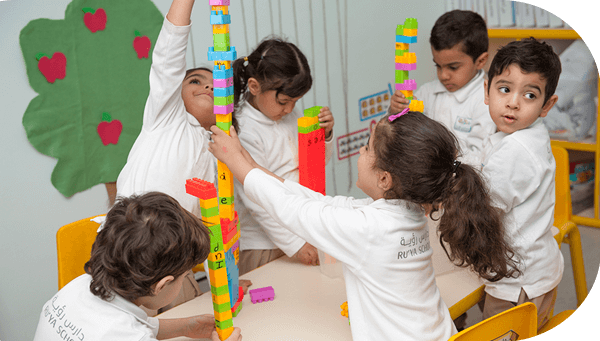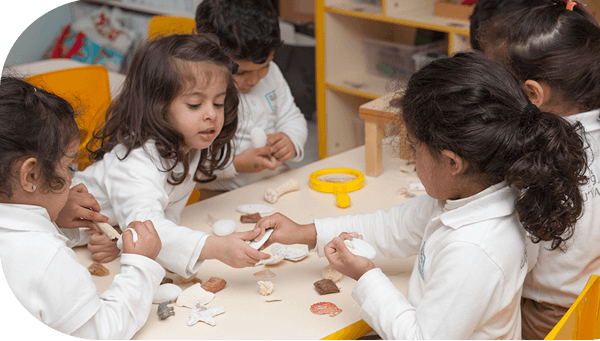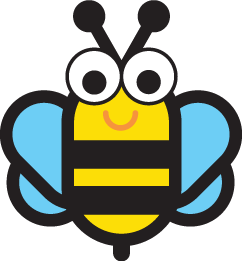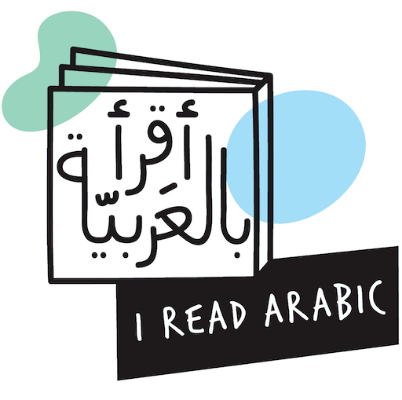Kindergarten in our Schools
Children at the age of 3 years begin their learning journey in kindergarten. The students in the classes are divided into two or three groups, taking into account the activity presented and the teacher-student ratio. Students in KG2 and KG3 are also provided with differentiated instruction by grouping them according to their reading level in Arabic and English, based on the results of standardized tests that the school conducts at the beginning of the school year.
This differentiation aims to provide activities and homework (if any) appropriate to the child’s level in each period, as we believe in the different abilities and needs of each child academically.
Academic Curriculum for Kindergarten
We adopt a bilingual program (Arabic-English) using the Creative Curriculum, which specializes in the nursery and kindergarten stages (from birth to the age of six). The curriculum is issued by
Teaching Strategies International, which is one of the leading companies in early childhood education in the United States and the world. It is approved and supervised by the American National Association for Early Childhood Education (NAEYC).
Despite the comprehensive variety of the curriculum in activities, assessment tools, professional development, and sources of support for parents, we continue to enrich it further in light of international standards appropriate to child development.
Additional Academic Curriculum for Kindergarten 3:
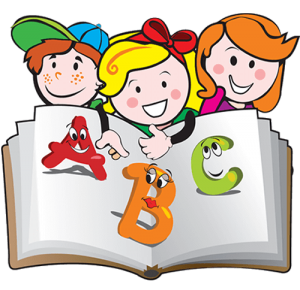
Balanced Literacy Approach
Reading to the students
The teacher builds love for reading in her students through reading different engaging texts including poetry, articles, news, informational texts.
Modeling Writing
Modeling correct spelling and writing proper sentences by understanding proper sentence structure and putting ideas into words.
Shared Reading (according to each unit)
The teacher reads with the students various texts according to the grade level of the students and models applying different reading and comprehension strategies.
Shared Writing (according to each unit)
The teacher writes the students’ ideas on a topic and formulates their ideas and turns them into paragraphs, with emphasis on the skills presented.
Guided Reading (Applying reading and Comprehension Strategies)
Students read texts chosen by the teacher according to their reading levels in small groups and are provided with continuous guidance and support from their teacher.
Guided Writing (Using Mind Maps)
Students write texts of their choice, going through the stages of writing: (determining the topic – brainstorming – writing – editing – evaluation)
Independent Reading
Students choose different texts to read and apply reading and comprehension strategies, and summarize content.
Independent writing
Students write texts of their choice freely and are given the opportunity to read the text in front of an audience.
Online Student Support Resources
Learning Units
The contents of this curriculum is assembled in units with topics that are connected to every child’s life at this specific age group. Each unit is covered within five to six weeks. A variety of topics are presented including religious, linguistic, mathematical and scientific concepts and social activities. The objectives of the curriculum also aim to link the child’s experiences with the surrounding environment and expand their perceptions through field trips related to the units. The units are:
Class Environment
Children are supervised at this stage by specialized teachers with high educational qualifications, such as a Bachelor’s degree in Kindergarten, a Bachelor’s degree in Special Education, or a Bachelor’s degree in English. They also possess first aid certificates, and periodically undergo suitable training within the professional development program in our schools.We also take into account the teacher to
student ratio according to global standards. They prepare classrooms so that they may be safe, efficient, and rich environments which aid our children’s growth in all aspects equally: socially, linguistically, artistically, and cognitively. Teachers also ensure that they build positive relationships with the children.
Children’s Assessments
Students are assessed through the Gold Objectives as part of the Creative Curriculum. Teachers take notes of important information related to the child’s development. Each quarter, parents receive a report which clarifies the level their child has reached based on each of the objectives of growth and learning. The objectives of growth and learning have been classified as 43 goals within 10 aspects related to growth, development, and learning.
The first 4 goals represent the main aspects of a child’s growth and development:
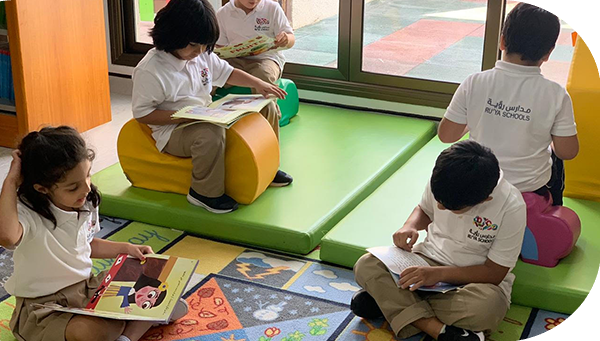
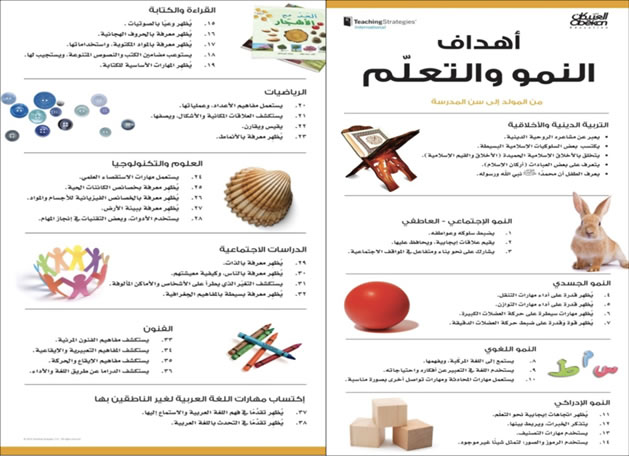
Furthermore, the next 6 goals represent the learning content, and are mainly considered outcomes of the early learning standards:
The 11th goal is related to Arabic language learners which aids the teacher in tracking the child’s development in learning the spoken language as well as expressions.
Daily Routine
25 minutes
Each child and his/her guardian is welcomed upon their arrival. Then, children put their personal belongings in the right place. The children spend their time playing in the activity corners or eating if they did not have breakfast at home.
30 minutes
The “question of the day” is discussed, and the children’s thoughts are recorded. The morning circle also includes the recitation of Quranic Surahs, practicing sight words, singing songs, and reading the calendar.
2 sessions per day (1 hour each)
Children are divided into three groups, a group to work on fine motor skills activities, a group to work on discovering science through fun and age-appropriate science experiments, and a group to listen to a story in English and work on the comprehension activities related to the text.
30 minutes
The children spend time outdoors jumping, running, and climbing. Teachers also participate in playing with children and offer them any support they need.
It is also a time for observing the weather, weather changes, plant growth, ants and insects.
30 minutes
The children and their teachers eat their healthy meals together in a calm, family-like atmosphere. While students are eating, they are guided to acquire social etiquette, religious etiquette, and self-reliance skills. Low tables are used during mealtimes to help children eat without the help of adults.
* Our school is free from all kinds of nuts.
2 periods per day (30 minutes each)
Children are divided into three groups, a group to work on fine motor skills activities, a group to work on discovering science through fun and age-appropriate science experiments, and a group to listen to a story in English and work on the comprehension activities related to the text.
20 minutes
It is the last meeting in which the teacher meets with the children before the end of school hours to discuss achievements made and ideas generated on that day. (This is done by telling a story or singing a song)
Field Trips
Field trips aim to form a relationship between the children and the surrounding world around them to give them the opportunity to interact directly with their environment and develop their senses and their abilities to observe, experience and discover.
Recreational Activities
Recreational activities aim to entertain and bring joy to the children through monthly activities for children and their teachers.
Values they have been taught are reinforced during these activities.
Parents-School Partnership
Once a year, each mother is scheduled a visit to partake in reading a story to the class with her child. This activity takes place before dismissal from 12:00 to 12:30 on Tuesday of every week.
It is held annually in the first quarter of the first semester, where the children take their parents on a tour inside the school to get acquainted with their classroom, gymnasium, school library, playgrounds, and enjoy playing together.
The Learning Exhibition is held annually in the last quarter of the second semester to reflect their learning journey during the school year, where students will display their learning outcomes in front of their family members and friends.
Family’s activities aim to involve the mother with her child in an artistic activity or physical games in a joyful atmosphere with his/her teachers, friends and other mothers. These activities are inspired by what has been learned and the skills utilized that children have implemented during the previous period. We stress the importance of the presence of the child’s mother or another person on her behalf for these activities. In the event that this is not possible, the parents must pick-up the child before the start of the activities as it could affect the child’s mental wellbeing.
Three basic meetings are held during the school year that are very important for the mother to attend.
First meeting of the academic year:
The first meeting is held on the first day of the school year to provide an opportunity for the mother and for the teachers to get to know each other, and for the mother to get to know the child by filling out an information form that will provide sufficient understanding of the child and his/her needs.
Meeting in the ninth week of each semester:
In this meeting, the progress of the child is discussed according to the goals of development and learning.
Other scheduled meetings at any time during the year:
Those who wish to meet again with the child’s teachers can book an appointment with the reception any time during the school year.
The festival aims to integrate concepts of voluntary work and to create the experience of buying and selling among our students, and provide them with the experiences of giving and empathizing with others.
All students in kindergarten and primary classes participate in the festival, where they sell products made by them in a large festival attended by their parents. All the proceeds are allocated to sponsoring orphans from The Charitable Society for Orphan Care in the Eastern Region Benaa’.
Student Policies and Regulations
Administration-Parent Communication
